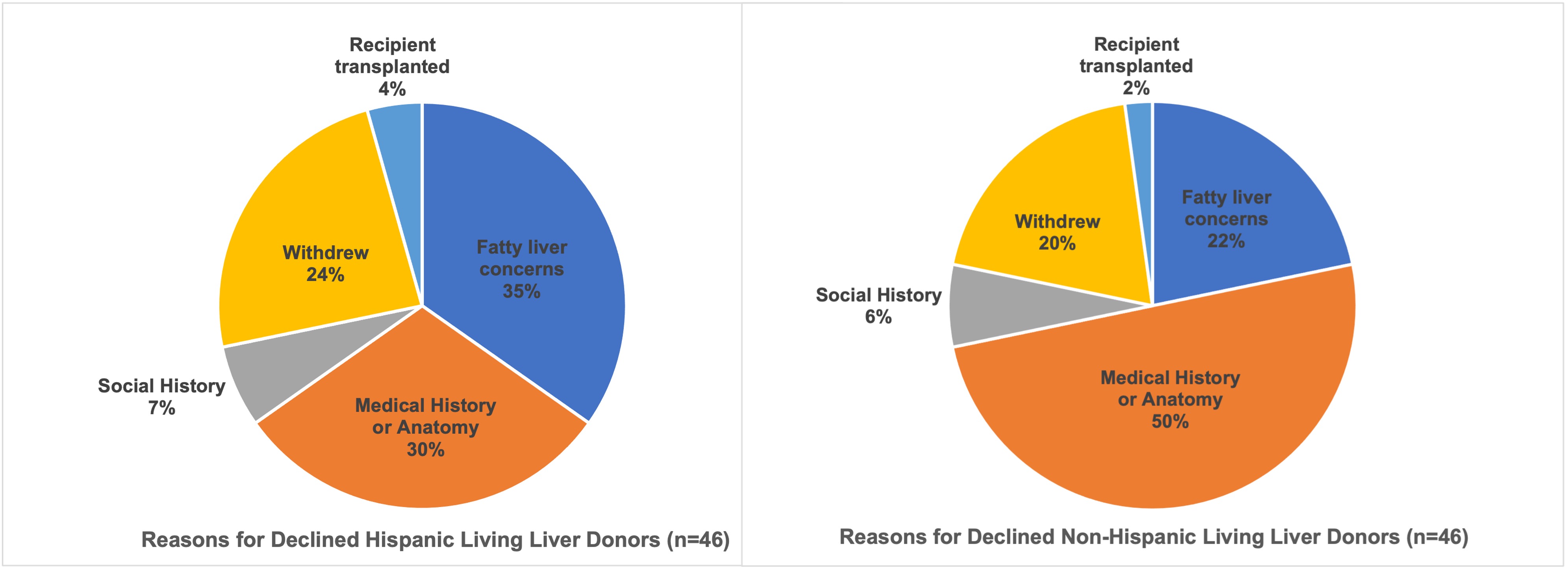A Qualitative Comparison of Declined Hispanic and Non-Hispanic Living Liver Donor Candidates at a High-Volume Urban Transplant Center
1Department of Medicine, University of Southern California, Los Angeles, CA, 2USC Transplant Institute, University of Southern California, Los Angeles, CA, 3Division of Gastrointestinal and Liver Diseases, University of Southern California, Los Angeles, CA, 4Department of Surgery, University of Southern California, Los Angeles, CA
Meeting: 2022 American Transplant Congress
Abstract number: 1763
Keywords: Hispanic, Liver transplantation, Living donor, Organ Selection/Allocation
Topic: Clinical Science » Liver » 58 - Liver: Living Donor Liver Transplant and Partial Grafts
Session Information
Session Name: Liver: Living Donor Liver Transplant and Partial Grafts
Session Type: Poster Abstract
Date: Tuesday, June 7, 2022
Session Time: 7:00pm-8:00pm
 Presentation Time: 7:00pm-8:00pm
Presentation Time: 7:00pm-8:00pm
Location: Hynes Halls C & D
*Purpose: To compare Hispanic and non-Hispanic living liver donor candidates who were declined by a multidisciplinary selection committee at a large urban transplant center.
*Methods: The Living Liver Donor Referrals Database was reviewed between December 1, 2017 and August 31, 2021 for applicants (n = 195) who completed a questionnaire and clinic evaluation, were presented to selection committee and formally approved/declined to serve as living donors. Statistical analysis was performed using Student’s t-test and chi-squared test.
*Results: Of 1,689 living liver donor applicants, 11.5% (n = 195) were presented to the committee, where nearly half were declined (47.2%, n = 92). Among those declined, half were Hispanic and half were non-Hispanic. When comparing reasons for decline, most Hispanics were declined due to fatty liver concerns (35% v. 22%, p = 0.39) in comparison to non-Hispanics. Most non-Hispanics were declined due to anatomy or other medical history (50% v. 30%, p = 0.39). Additional reasons for decline when comparing Hispanic and non-Hispanic candidates were similar: application withdrawal (24% v. 20%, p = 0.39), social history (7% v. 6%, p = 0.39), recipient transplanted (4% v. 2%, p = 0.39). Declined Hispanic and non-Hispanic donor candidates were commonly family members (80% v. 58.7%, p = 0.08), although more than one quarter were friends of intended recipients among declined non-Hispanics (28.3% v. 15.6%, p = 0.08). Some donor candidates were presented multiple times. There was no difference when comparing mean number of presentations to the committee among declined Hispanic and non-Hispanics donor candidates (1.39 v. 1.37, p = 0.89).
*Conclusions: At our center, there was no significant difference in reasons for decline by the committee when comparing declined Hispanic and non-Hispanic living liver donor candidates. This suggests that the disparity among Hispanics in LDLT occurs elsewhere, such as earlier in the donor evaluation process or could even be related to illness severity of intended recipients. There are ongoing efforts to establish multi-center comprehensive donor candidate registries that may reveal how donor evaluation processes at various centers may influence disparities in particular regions.
To cite this abstract in AMA style:
Toy D, Horwich B, Mulgaonkar A, Padilla A, Dodge JL, Kaur N, Han H. A Qualitative Comparison of Declined Hispanic and Non-Hispanic Living Liver Donor Candidates at a High-Volume Urban Transplant Center [abstract]. Am J Transplant. 2022; 22 (suppl 3). https://atcmeetingabstracts.com/abstract/a-qualitative-comparison-of-declined-hispanic-and-non-hispanic-living-liver-donor-candidates-at-a-high-volume-urban-transplant-center/. Accessed December 24, 2025.« Back to 2022 American Transplant Congress

